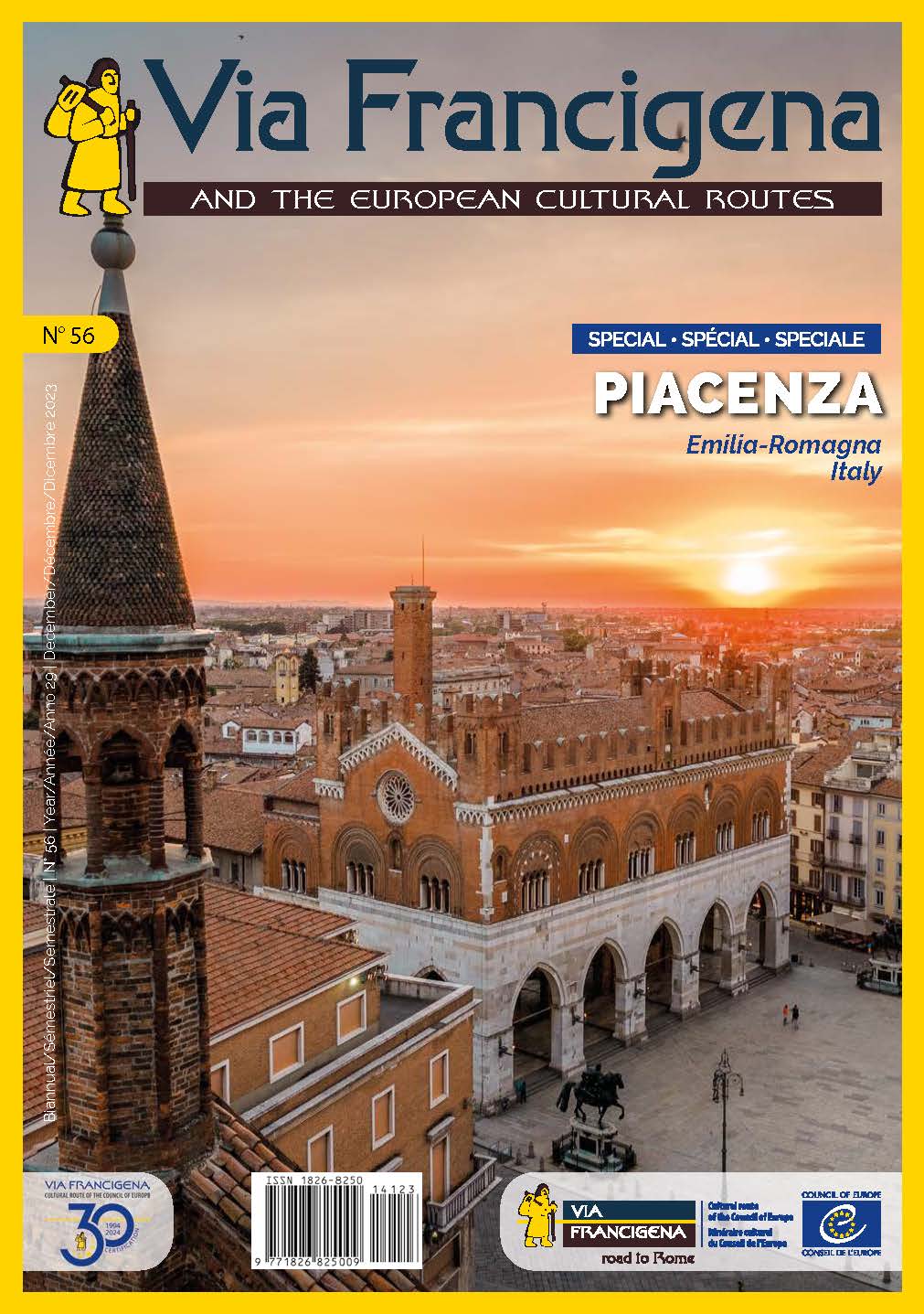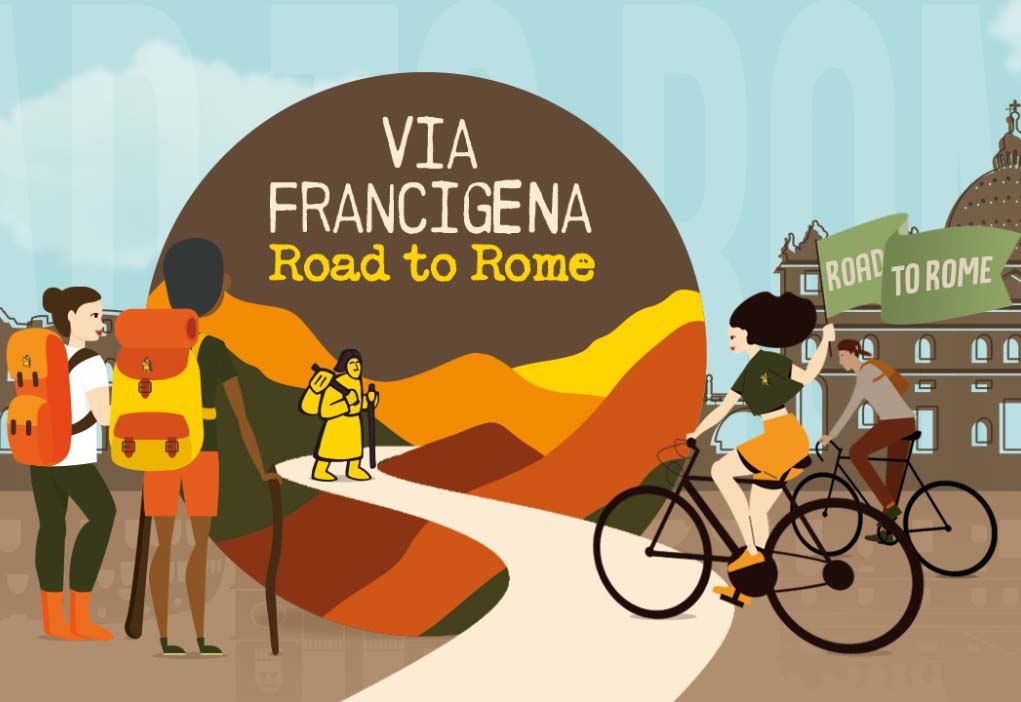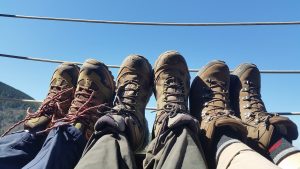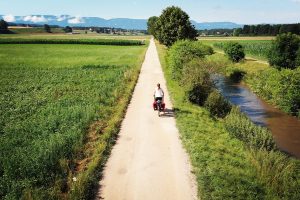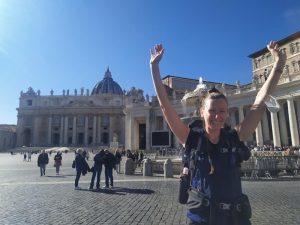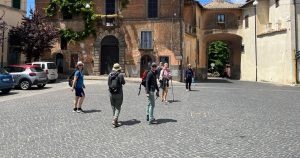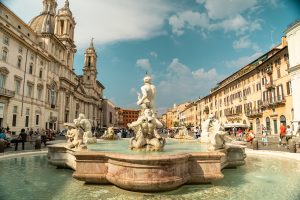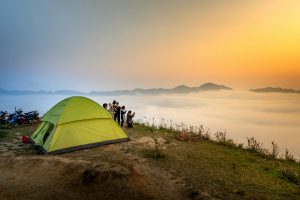With the region of Apulia, we open the first chapter of our travel diary, which recounts the entire Via Francigena route in celebration of the 2025 Jubilee.
Stretching over 3,200 km, this historic medieval itinerary crosses five countries (England, France, Switzerland, Vatican City, and Italy), sixteen regions, and more than six hundred municipalities, as we detail in the itinerary. Starting in Kent, UK, it touches the regions of Hauts-de-France, Grand Est, and Bourgogne-Franche-Comté in France; the cantons of Vaud and Valais in Switzerland; the regions of Aosta Valley, Piedmont, Lombardy, Emilia-Romagna, Liguria, Tuscany, Lazio, Campania, and Puglia in Italy. Finally, in Rome, it reaches the Vatican, the symbolic heart of the Jubilee.
For these special regional features created in collaboration with Regione Lazio, we’ve chosen to recount and follow the Via Francigena from south to north, guiding you through each region to immerse ourselves in its scenic, historical, and gastronomic beauties. Along the way, we’ll offer plenty of travel tips about the pilgrimage route, with highlights of the stages and some curiosities.
Are you ready to join us on this journey?
Let’s begin!
Table of Contents
- History and Faith: Brindisi, Santa Maria di Leuca, and the stages of Monte Sant’Angelo and Bari
- Cultural Heritage: Torre Guaceto, Apulian Romanesque, and Lecce Baroque
- Nature and Landscapes: The Valle d’Itria and Salento
- Gastronomy: Between Tradition and Authentic Flavours
- Walks for a Long Weekend or Short Break
- Some Tips
History and Faith: Brindisi, Santa Maria di Leuca, and the Stages of Monte Sant’Angelo and Bari
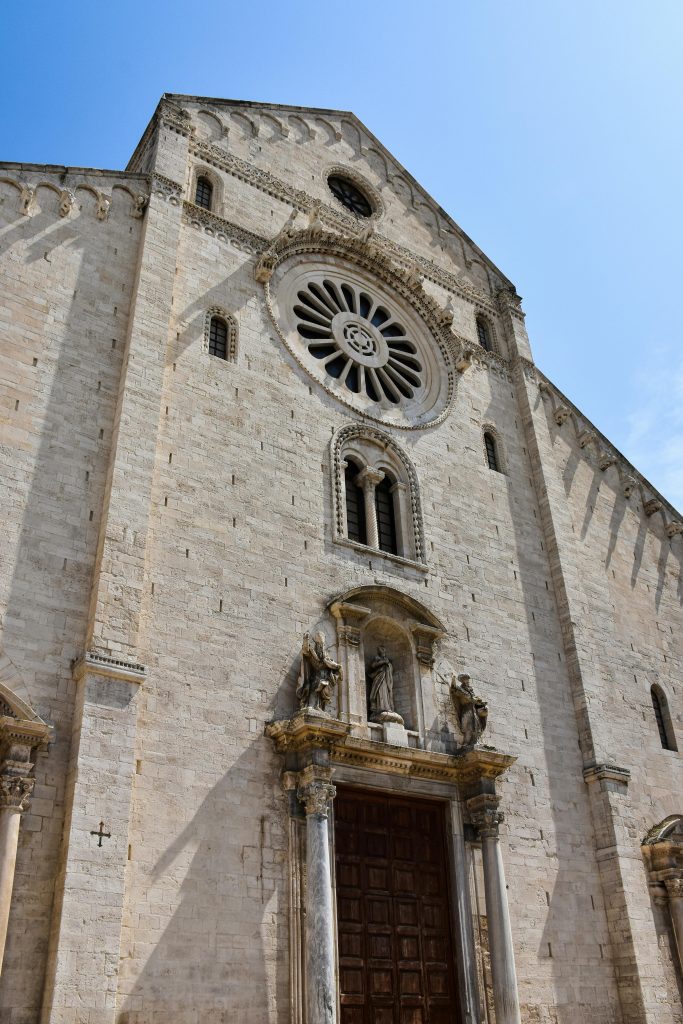
The Via Francigena in Apulia has deep roots, dating back to the Middle Ages, retracing the millennium-old pilgrimage paths of those who, coming from Northern Europe, headed towards Rome seeking protection from the Pope and later towards the Sanctuary of Monte Sant’Angelo and the ports for the East and the Holy Land. These routes, although closely linked to devotion, have seen pilgrims, merchants, soldiers, scholars, crusaders, Templars, and great thinkers pass through over the centuries. Already in Roman times, with the construction of the Via Appia and Via Traiana, important road arteries were established connecting Brindisi, a strategic port, to the rest of the ancient world.
Brindisi is the starting point for those journeying from the south, thanks to its strategic position as a port for travel to the East. In the city, pilgrims can receive the Testimonium, a certificate acknowledging their passage through Brindisi, issued at the Statio Peregrinorum as a sign of the completed journey.
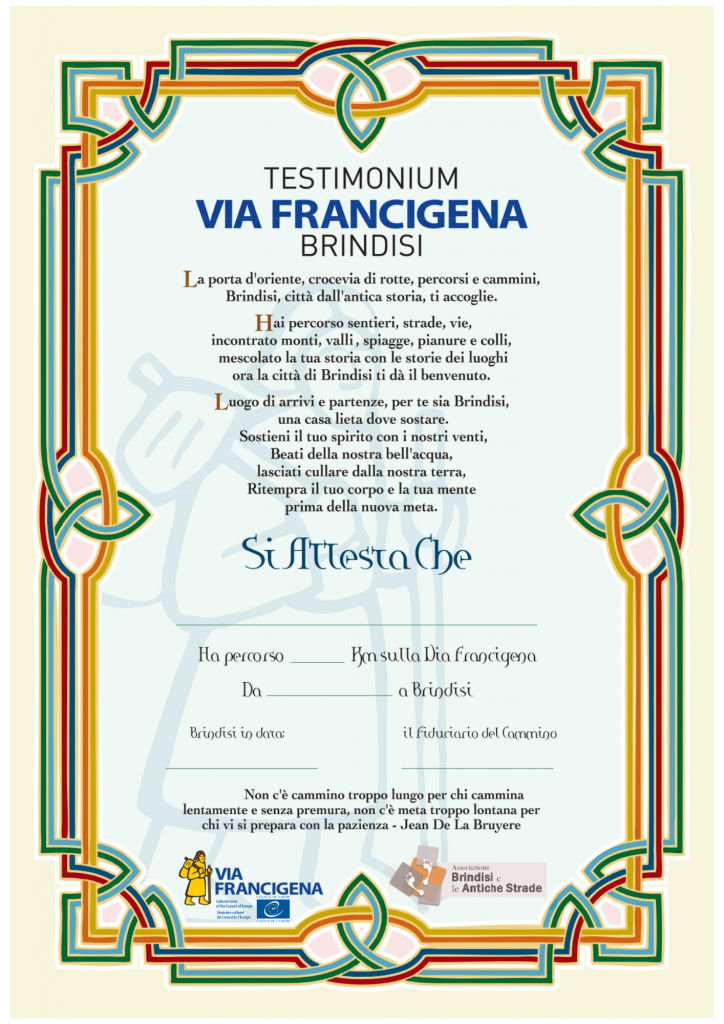
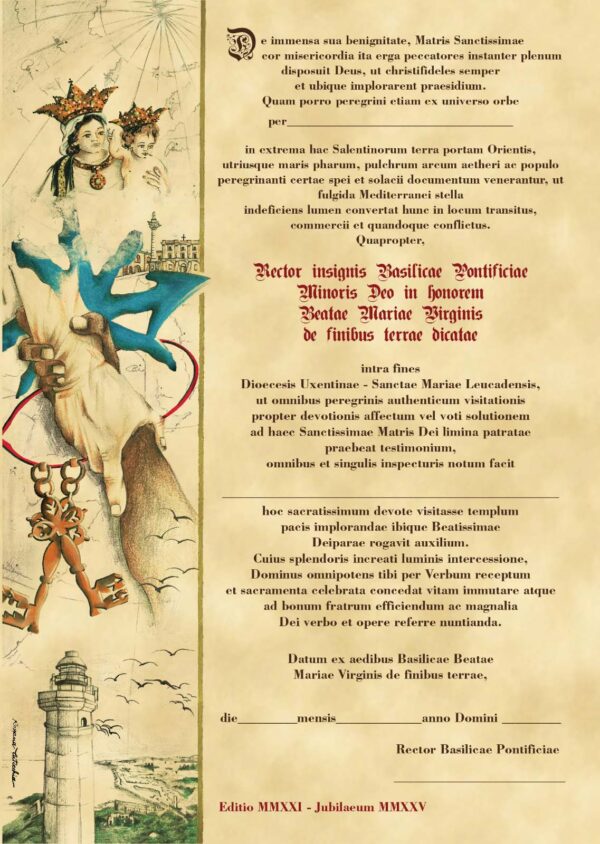
Another significant stop is Bari, where pilgrims visit the Basilica of San Nicola, one of the most important places of worship for both Orthodox and Catholic Christianity. The Basilica houses the relics of St. Nicholas, which were brought here in 1087 from Myra (modern-day Turkey), becoming a major pilgrimage site for people across Europe.
Heading further south, we reach Santa Maria di Leuca, the southernmost point of Apulia, whose ancient name was Leuca, from the Greek leukos, meaning white, due to the color of the rocks illuminated by the breaking waves. Historically known as the “Finis Terrae” of Italy, the border of the land, it is here that pilgrims would traditionally stop before continuing their journey to the Holy Land or heading to Rome. The breathtaking beauty of the landscape, where the Ionian and Adriatic seas meet, represents an unmissable destination, a symbol of hope and arrival for those who have walked this long path. Climbing the lighthouse, built in the 19th century and the second tallest in Europe at 47m with 245 steps, you can enjoy a stunning view from its terrace. The Testimonium can also be obtained here at the Pontifical Sanctuary Basilica.
- Fun Fact: Tiggiano – Church of Sant’Ippazio
Not far from Santa Maria di Leuca, we recommend visiting Tiggiano, a small medieval village, where the heart of the town is the Church of Sant’Ippazio, the patron saint and protector of male virility, celebrated with the curious Sagra della Pestanaca di Sant’Ippazio – a yellow-violet carrot.
One of the most spiritual points along the Via Francigena in Puglia is Monte Sant’Angelo, famous for its Sanctuary of St. Michael the Archangel, which has attracted pilgrims since the Middle Ages. The sanctuary is located in a natural cave, traditionally believed to be the place where St. Michael appeared in 490 AD, marking the start of a cult that has engaged generations of believers. The town of Monte Sant’Angelo, set in a rural and mountainous context, also offers medieval architecture that preserves the charm and sanctity of the past.
- Fun Fact: The Legend of St. Michael at Monte Sant’Angelo
According to tradition, the devil, jealous of the growing devotion to St. Michael, tried to destroy the sanctuary. But the archangel, with a blow of his sword, drove away the dark forces and saved the sacred place, which has since been inviolable and protected by his presence.
Cultural Heritage: Apulian Romanesque and Lecce Baroque

Apulia is also a region rich in history and art.
The architecture of Apulian Romanesque, in fact, is another fascinating aspect for pilgrims along the route. The Cathedral of Trani, with its imposing façade and strategic coastal location, is one of the most famous examples of this style. The Cathedral of Andria, with its distinctive Latin cross design, and Bari’s cathedral, which maintains a sober and austere appearance, are other unmissable stops for lovers of medieval architecture.
As you reach the heart of Apulian Baroque, Lecce stands out as one of the jewels of Italian Baroque art. The city is renowned for its splendid historic centre, where every corner and façade tells a story of artistic grandeur. The Lecce Cathedral, with its grand portal and intricate sculptural decoration, is an extraordinary example of this style, which is distinctive for its use of local stone called carparo, giving the churches and buildings a unique, radiant appearance. Lecce is also the perfect place to immerse yourself in the Baroque atmosphere, wandering through churches, noble palaces, and lively squares.
Nature and Landscapes: Torre Guaceto, the Valle d’Itria, and Salento
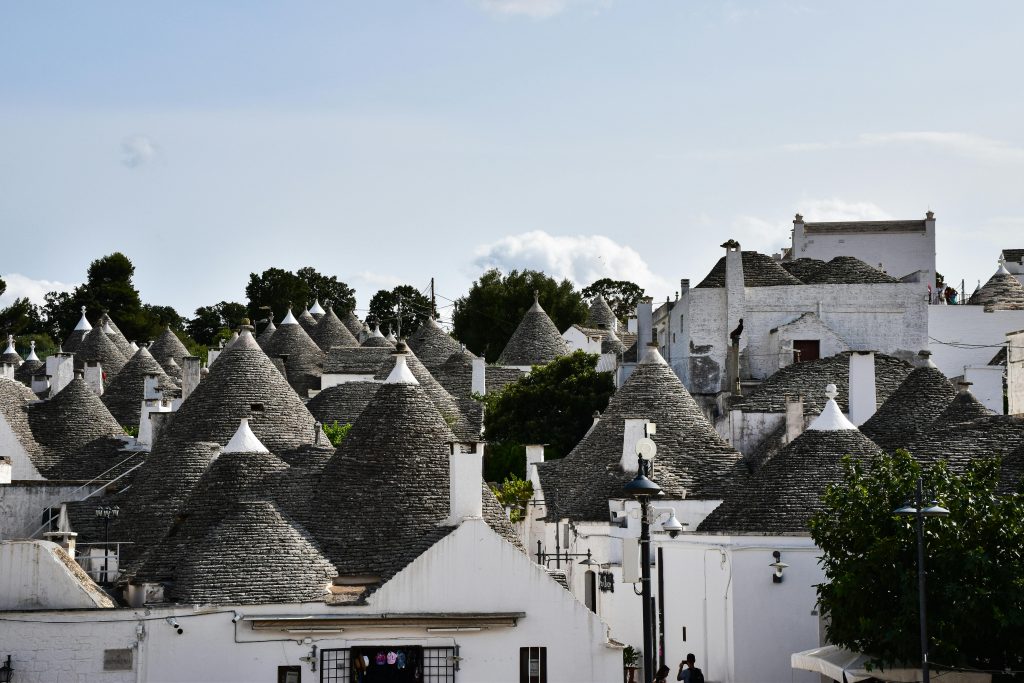
The natural beauty of Apulia is another crucial element of the journey along the Via Francigena.
A prime example of natural heritage is the Torre Guaceto Nature Reserve, one of the most important protected areas in the region, located along the Adriatic coast. The reserve is a zone of great biodiversity, home to numerous species of migratory birds and Mediterranean scrub vegetation. Its history is also tied to archaeological finds, which testify to the passage of ancient civilisations that have left indelible marks on the land.
But it is the Valle d’Itria, with its characteristic trulli, that is one of the most evocative areas of the region. The trulli of Alberobello, a UNESCO World Heritage site, are the emblematic structures of this region, which spans the provinces of Bari, Brindisi, and Taranto. Along with the trulli, the valley is dotted with ancient villages, farmhouses, and centuries-old olive groves, offering breathtaking panoramic views.
Salento, the southernmost part of Apulia, offers sandy beaches, cliff-side shores, and quaint coastal towns. Among the most enchanting spots is once again Santa Maria di Leuca, with its lighthouse and crystal-clear waters, where pilgrims can enjoy a landscape that has united the spirituality of the pilgrimage with the beauty of nature for centuries. The Salento villages, like Otranto and Gallipoli, are famous for their traditions, cuisine, and the charm of their historical heritage.
Gastronomy: Between Tradition and Authentic Flavours
Another element that makes the journey along the Via Francigena in Puglia unique is the local gastronomy, which reflects the region’s history and traditions.
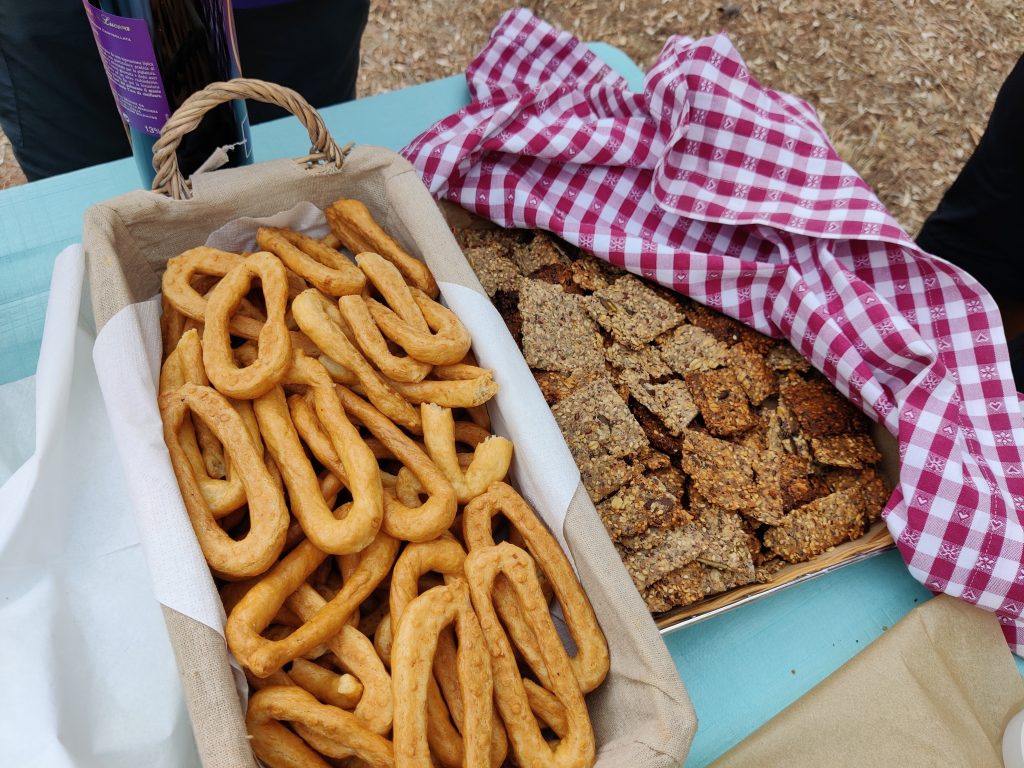
Among the most iconic dishes are orecchiette, a type of handmade pasta from Apulia made with durum wheat semolina. These pasta are traditionally served with a sauce made from cime di rapa (turnip greens), a dish that has become a symbol of Apulian cuisine. This simple yet flavourful dish represents the essence of Mediterranean cuisine, based on fresh, authentic ingredients.
Another popular local treat is taralli, crispy ring-shaped snacks made from an unleavened dough of flour, extra virgin olive oil, and white wine. These are prepared by mixing the ingredients into dough, forming it into small sticks, shaping them into rings, boiling them briefly, and then baking them. There are various versions, with seasonings such as fennel seeds, olives, onions, and herbs, and some even come in a sweet version, perfect for a quick break during the walk.
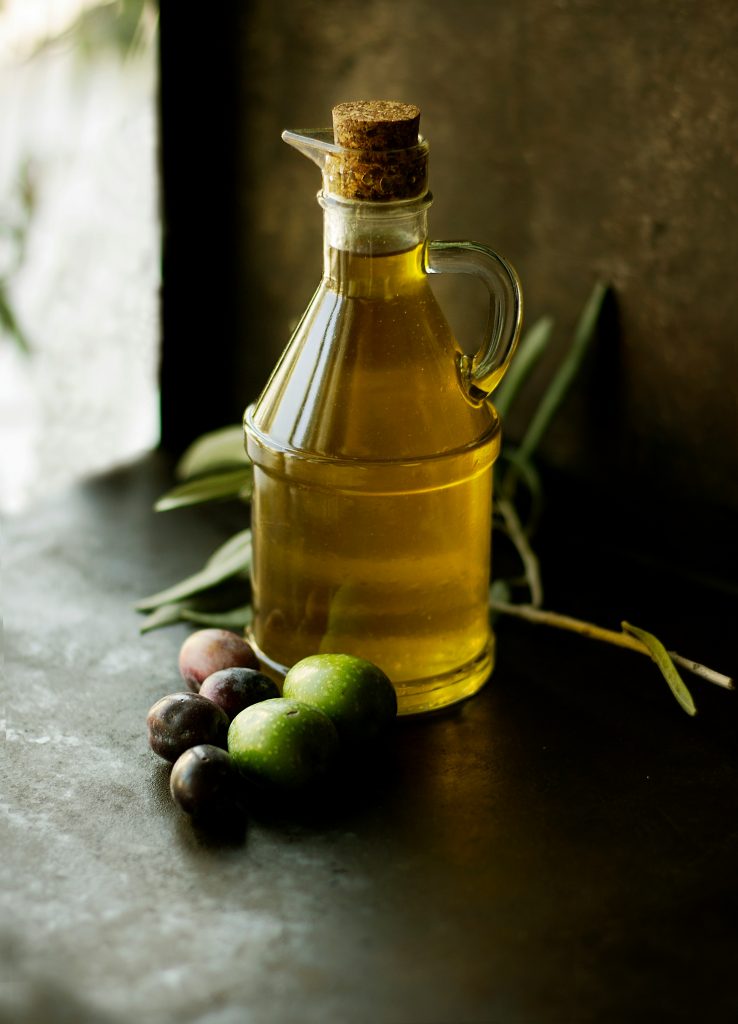
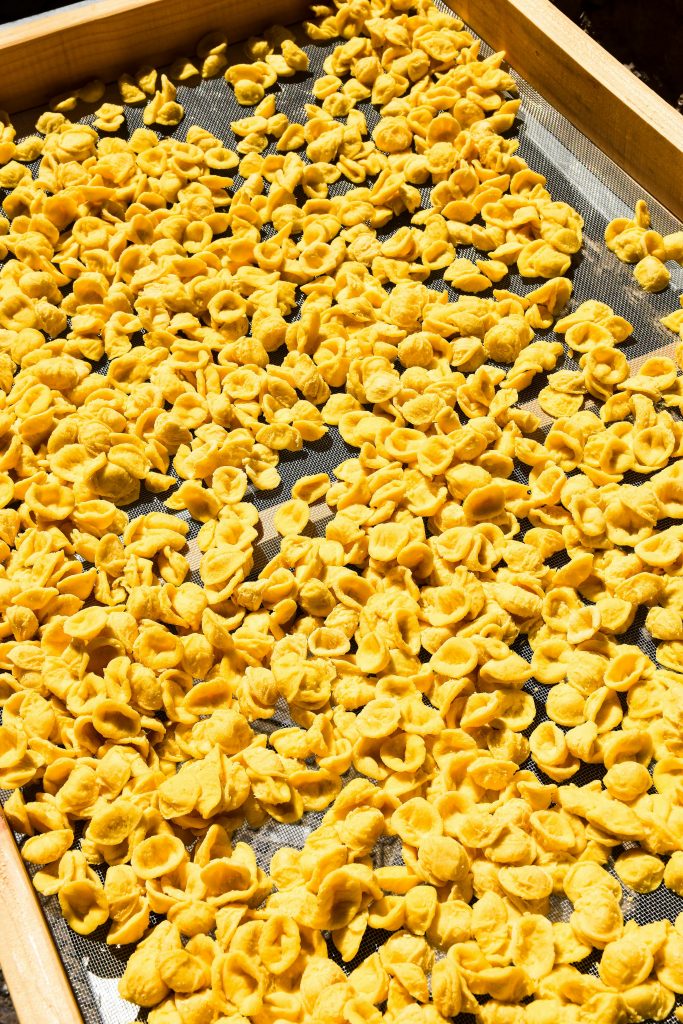
But no discussion of Apulian cuisine would be complete without mentioning extra virgin olive oil, one of the region’s finest products. Apulian olive oil is known for its fruity and slightly peppery flavour, and it is used in almost every local dish, from pasta to bread, salads, and fish-based meals.
- Fun Fact: Orecchiette have their roots in ancient Apulian peasant traditions, where women used simple ingredients like durum wheat semolina and water to make fresh pasta for their families. Taralli, on the other hand, have rural origins, often consumed during festivals or as a snack while working in the fields.
Walks for a Long Weekend or Short Break
2-Day Itinerary (San Giovanni Rotondo – Manfredonia)
- Day 1: The first leg begins from San Giovanni Rotondo to Monte Sant’Angelo (21.8 km), taking you through the Gargano. Along the way, you’ll be treated to views of the sea and the town of Monte Sant’Angelo, one of Europe’s oldest pilgrimage destinations. The history of the town is closely tied to St. Michael the Archangel and the construction of the Sanctuary in his honour, dating back to the 5th-6th centuries. In the basilica, pilgrims can access the Sacred Cave (also known as the Celestial Basilica) and receive the Testimonium. The sanctuary was declared a UNESCO World Heritage site in 2011.
- Day 2: The second leg takes you from Monte Sant’Angelo to Manfredonia (13.9 km), a shorter, yet medium-intensity stretch. Manfredonia, known as the gateway to Gargano, is one of the oldest and most historically significant towns in Puglia. Here, you can visit the Castle and the Daunian stele, stroll along the seafront, or explore the Laguna del Re. If you’re there in late August, you might catch the Patronal Festival of Manfredonia, dedicated to the Madonna of Siponto.
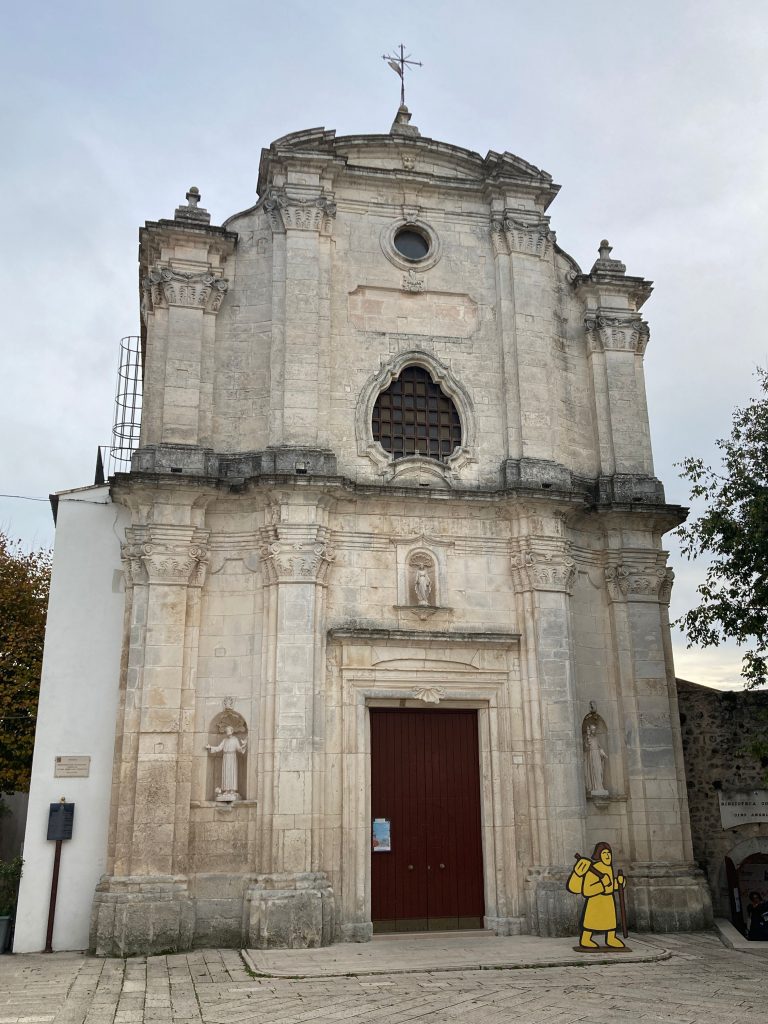
3-Day Itinerary (Bari – Monopoli)
- Day 1: From Bari to Mola di Bari (23 km), a fairly easy first day that introduces you to the coastal wonders along the route. You’ll pass charming fishing villages, hidden coves, and inland areas with trulli, historic farmhouses, and dry stone walls framing olive groves.
- Day 2: From Mola di Bari to Polignano a Mare (16 km), where you’ll admire the coastal trulli of Ripagnola and the dramatic Abbey of San Vito, before reaching Polignano a Mare, a pearl of the Adriatic.
- Day 3: From Polignano a Mare to Monopoli (12 km), this last stage is marked by small, enchanting coves, continuing until the ancient port of Monopoli. The town’s centre is full of historical buildings, including the Castle of Charles V and Palazzo Martinelli.

6-Day Itinerary (Lecce – Santa Maria di Leuca)
The route from Lecce to Santa Maria di Leuca takes you through the heart of Salento, offering a perfect blend of natural beauty, historic traditions, religious sites, and genuine hospitality.
- Day 1: Arrive in Lecce, the queen of Baroque, and visit the Cathedral of Maria Santissima Assunta, the Church of Saints Niccolò and Cataldo, and the historic centre, starting with the beautiful Monumental Gates and ending at the splendid Piazza Duomo and the magnificent Basilica of Santa Croce.
- Day 2: Departure for Martano (30.6 km), the heart of Greek Salento. Along the way, we recommend visiting Acaya, Vernole, and the Salento Natural History Museum.
- Day 3: Another long stage takes you from Martano to Otranto (around 30 km), the easternmost town in Italy. It was here, in 333 AD, that the pilgrim from Bordeaux began his journey back, whose diary forms the basis of the Via Francigena in the South. The town is home to the Cathedral of Santa Maria Annunziata, the Church of San Pietro, and the imposing Castle.
- Day 4: Arrival in Vignacastrisi (24 km). Along the way, you’ll pass by the Bauxite Lake, the ruins of the Abbey of San Nicola di Casole, and, with an extra 2 km, you can visit Castro, the legendary site where Aeneas landed in Italy.
- Day 5: This is a lighter stage, leading to Tricase (14.1 km), which was founded in the 12th century from the union of three houses, hence the name. Among its streets, you’ll find interesting buildings such as the Palazzo Gallone, the Church of the Nativity of the Blessed Virgin Mary, and the Church of San Michele Arcangelo.
- Day 6: Finally, on the sixth and last day of the journey, we suggest the stage from Tricase to Santa Maria di Leuca (18 km), the end point of the Via Francigena in the South. On the way to reach the Finis Terrae of Italy, we recommend visiting Tiggiano, Corsano, and Gagliano del Capo.
If you’re looking for advice on how to reach Lecce, you can find various options here.
If you wish to discover how to return from Santa Maria di Leuca, here’s some information.
We also suggest checking out FlixBus offers. By entering your pilgrim credential, you’ll be eligible for a discount reserved for pilgrims.
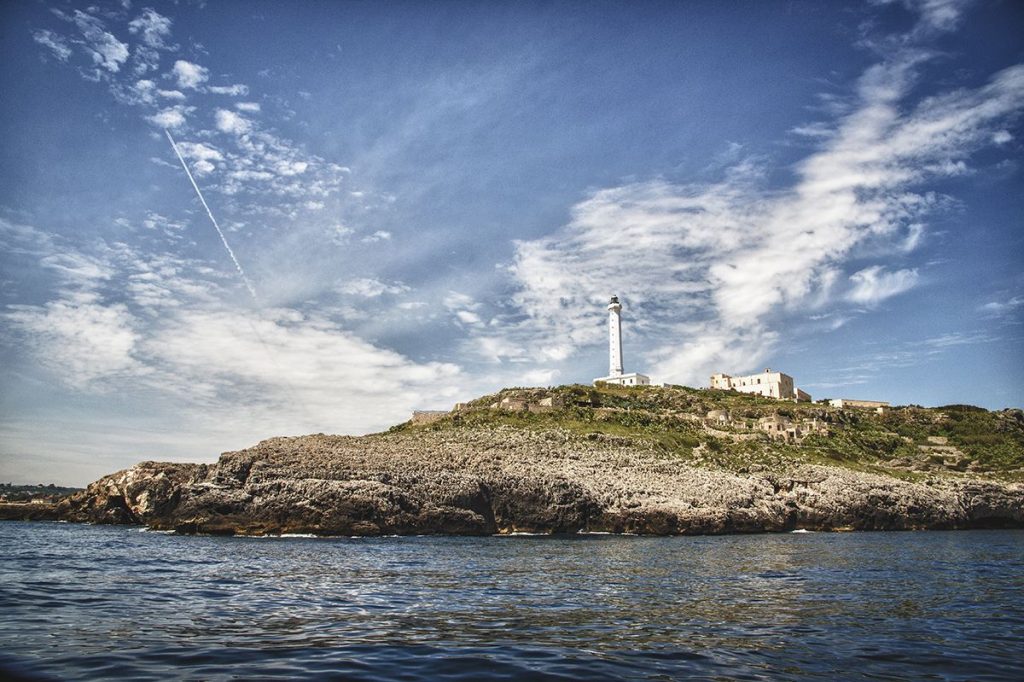
Some tips
- Prepare Your Equipment
Hiking Shoes: Choosing the right shoes is crucial, especially for long distances. Opt for sturdy and comfortable shoes with good breathability and solid foot support. Lightweight hiking shoes are ideal for longer routes. Here are some recommendations.
Backpack: Choose a comfortable, lightweight backpack. Ensure it has adjustable straps and proper ventilation. It is essential not to overload your bag; only pack the essentials. Here are a few ideas.
Clothing: Bring breathable, comfortable, and lightweight clothes. Depending on the season, add a waterproof jacket for protection against rain or wind, and a hat or cap for sun protection. If you’re unsure where to find them, look here.
Trekking Poles: These are extremely useful for reducing strain on the knees, especially during uphill or downhill stretches. Find them here.
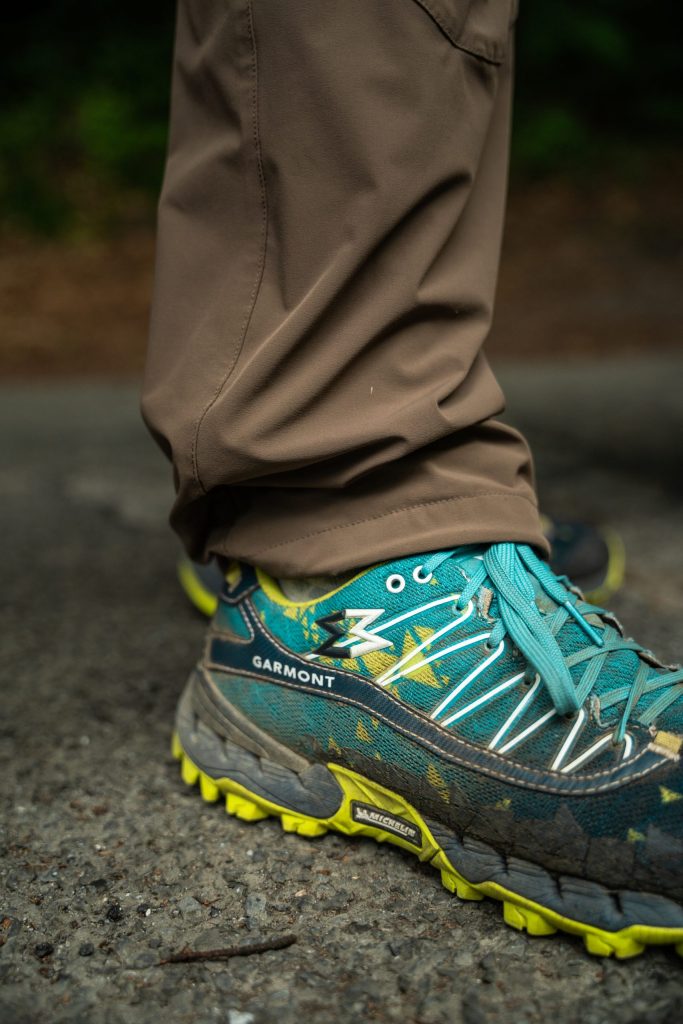
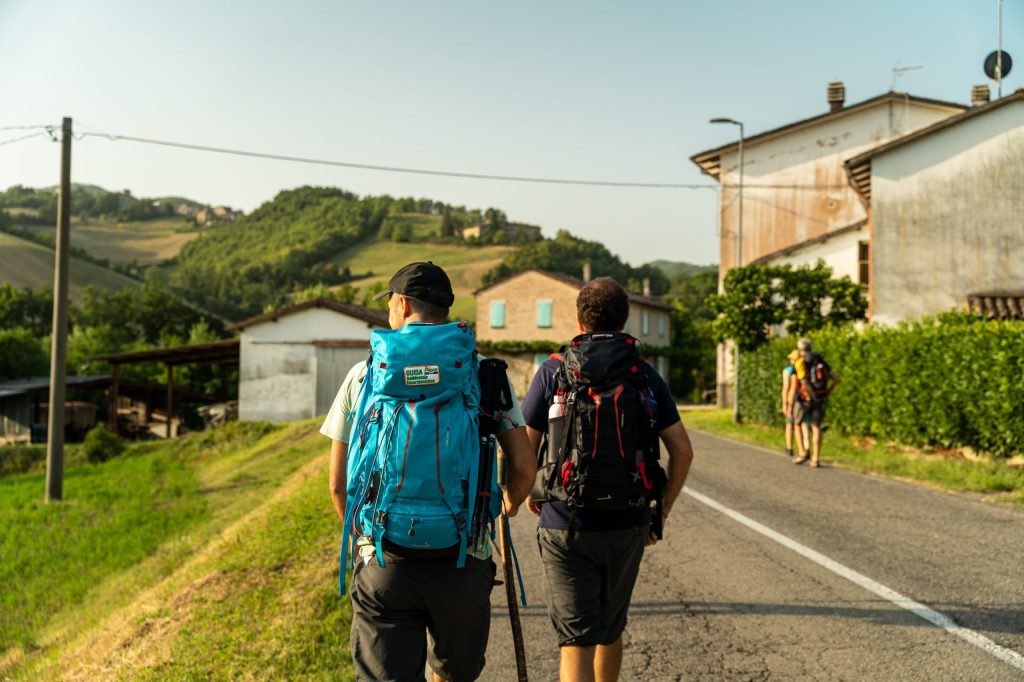
- Plan Your Stages and Routes
Distance and Time: Each day of walking involves distances ranging from 15 to 25 km. If you’re not accustomed to walking long distances, plan shorter stages to start with. A good idea is to complete the route over several days, depending on your capabilities.
Where to Stay: Along the route, you’ll find numerous accommodation options, such as hostels, B&Bs, agriturismi, and monasteries. In some places, you can also benefit from hospitality at pilgrim refuges. Book in advance, especially during peak seasons (spring and summer).
Adaptability: Not all stages are of the same difficulty. Be flexible, and if necessary, adjust your plans. Remember, the journey is not a race, but rather a personal and spiritual discovery experience.
- Safety and Health
Water and Food: Always carry a bottle of water with you. Some stages of the route may not have easily accessible water sources, so it’s important to refill at major stops. Don’t forget to bring energy snacks, such as dried fruit, cereal bars, and nuts.
Sun Protection: The sun in southern Italy can be intense, especially in the summer. Use a high SPF sunscreen, sunglasses, and a hat.
Rest: Listen to your body. Don’t hesitate to take breaks and rest when needed. Muscles and joints may suffer during the walk, so taking recovery moments is essential.
Article published as part of the intervention: Fondo Sviluppo e Coesione – Development and Cohesion Plan, managed by the Italian Ministry of Culture (Sheet 33 – Via Francigena – Cross-cutting Actions. Transmission of project sheet “Communication and Promotion Plan”).






